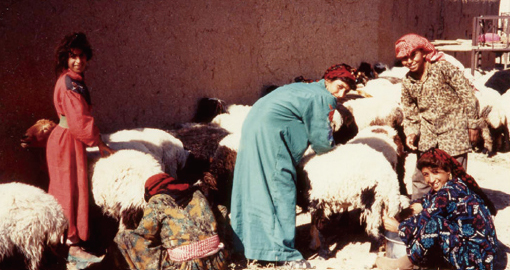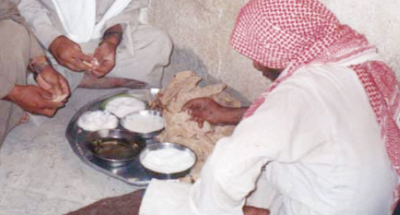Project Leader:HIRATA, Masahiro (School of Agriculture, University of Agriculture and Veterinary Medicine)
Collaborators: MATSUBAYASHI, Kozo (Center for Southeast Asian Studies, Kyoto University)
INAMURA, Tetsuya (School of Foreign Studies, Aichi Prefectural University)
MIYAKE, Yutaka (Graduate School of Humanities and Social Sciences, University of Tsukuba)
TSUKIHARA, Toshihiro (Faculty of Education and Regional Studies, University of Fukui)
Term:2012-2013
Outline of Research:

Milking by a Baqqara group, Arab pastoralist in North-east Syria. The milking is basically the task of woman and child. One holds sheep and goats tightly, another conducts milking with two-hands from between those back legs. The milk culture, milking, milk processing and uses of milk products, forms the base of pastoralist’s subsistence.
In research into Old Continent dry areas milk cultures (such as milking, milk processing, and the uses of milk and milk products for living) have been essential for pastoralists. The lack of a milk culture for subsistence has, however, has been reported in research conducted in the New Continent and Southeast Asia. Since many detailed case studies on pastoralist cultures have reported about pastoralism in these areas, it is now time to reconsider the theory and definition of pastoralism from a wider perspective. This research reconsiders the theory of pastoralism subsistence from the viewpoint of milk culture. In detail, it will look at those techniques important for pastoralists such us the procurement of food, flock management, selection and breeding of livestock, and broad trade.This will be done to present a structural comparison of pastoralism between the dry areas of the Old Continent where milk culture forms the base of pastoralist’s subsistence, and the New Continent and Southeast Asia where the milk culture is missing in local people’s subsistence. Finally, this research will present a new model and definition of pastoralism
Purpose of the research:

Dietary intake which depends largely on milk and milk products, in a Baqqara group, Arab pastoralist, North-east Syria. There are fermented milk “khaather”, butter “zibde”, butter-oil “samneh”, sugar and naan “khobz” on the plate. The dietary intake in the Baqqara consists of milk and milk products mainly, rather than meats.
The purpose of this research is to reconsider the subsistence theory of pastoralism, keeping milk culture in mind, through a comparative analysis of pastoralism in both the dry areas of the Old Continent, and the New Continent and Southeast Asia. The main topics for the discussion are as follows: 1) the subsistence of pastoralists such as their structure, management of livestock keeping, mobility, relationships with farmers and trade, and 2) Ecological-anthropological studies such us a detailed breakdown of food intake and strategies of food procurement. This research will also try to set up a new model and definition of pastrolism.
Significance of the research
It has been said that milk cultures function as a basic aspect of pastoralist’s subsistence. Through a comparison of pastoralism structures in both the Old Continent and the New Continent, we can reconsider milk culture through this research. Since a discussion from the unique perspective of milk culture can allow us to discover new aspects in a theory of pastoralism, this research hopes to greatly contribute to the field. These results will offer a new concept and model of pastoralism.
